EFM32G200F32 Energy Micro, EFM32G200F32 Datasheet - Page 5

EFM32G200F32
Manufacturer Part Number
EFM32G200F32
Description
MCU 32BIT 32KB FLASH 32-QFN
Manufacturer
Energy Micro
Series
Geckor
Datasheets
1.EFM32G200F16.pdf
(63 pages)
2.EFM32G200F16.pdf
(10 pages)
3.EFM32G200F16.pdf
(463 pages)
4.EFM32G200F16.pdf
(136 pages)
Specifications of EFM32G200F32
Core Processor
ARM® Cortex-M3™
Core Size
32-Bit
Speed
32MHz
Connectivity
EBI/EMI, I²C, IrDA, SmartCard, SPI, UART/USART
Peripherals
Brown-out Detect/Reset, DMA, POR, PWM, WDT
Number Of I /o
24
Program Memory Size
32KB (32K x 8)
Program Memory Type
FLASH
Ram Size
8K x 8
Voltage - Supply (vcc/vdd)
1.8 V ~ 3.8 V
Data Converters
A/D 4x12b, D/A 1x12b
Oscillator Type
External
Operating Temperature
-40°C ~ 85°C
Package / Case
32-VQFN Exposed Pad
Processor Series
EFM32G200
Core
ARM Cortex-M3
Data Bus Width
32 bit
Data Ram Size
8 KB
Interface Type
I2C, UART
Maximum Clock Frequency
32 MHz
Number Of Programmable I/os
24
Number Of Timers
2
Operating Supply Voltage
1.8 V to 3.8 V
Maximum Operating Temperature
+ 85 C
Mounting Style
SMD/SMT
Minimum Operating Temperature
- 40 C
Lead Free Status / RoHS Status
Lead free / RoHS Compliant
Eeprom Size
-
Lead Free Status / Rohs Status
Details
2.1.15 Real Time Counter (RTC)
2.1.16 Low Energy Timer (LETIMER)
2.1.17 Pulse Counter (PCNT)
2.1.18 Analog Comparator (ACMP)
2.1.19 Voltage Comparator (VCMP)
2.1.20 Analog to Digital Converter (ADC)
2.1.21 Digital to Analog Converter (DAC)
2.1.22 General Purpose Input/Output (GPIO)
2010-12-17 - d0003_Rev1.20
The Real Time Counter (RTC) contains a 24-bit counter and is clocked either by a 32.768 kHz crystal
oscillator, or a 32 kHz RC oscillator. In addition to energy modes EM0 and EM1, the RTC is also available
in EM2. This makes it ideal for keeping track of time since the RTC is enabled in EM2 where most of
the device is powered down.
The unique LETIMER
in addition to EM1 and EM0. Because of this, it can be used for timing and output generation when most
of the device is powered down, allowing simple tasks to be performed while the power consumption of
the system is kept at an absolute minimum. The LETIMER can be used to output a variety of waveforms
with minimal software intervention. It is also connected to the Real Time Counter (RTC), and can be
configured to start counting on compare matches from the RTC.
The Pulse Counter (PCNT) can be used for counting pulses on a single input or to decode quadrature
encoded inputs. It runs off either the internal LFACLK or the PCNTn_S0IN pin as external clock source.
The module may operate in energy mode EM0 – EM3.
The Analog Comparator is used to compare the voltage of two analog inputs, with a digital output indi-
cating which input voltage is higher. Inputs can either be one of the selectable internal references or from
external pins. Response time and thereby also the current consumption can be configured by altering
the current supply to the comparator.
The Voltage Supply Comparator is used to monitor the supply voltage from software. An interrupt can
be generated when the supply falls below or rises above a programmable threshold. Response time and
thereby also the current consumption can be configured by altering the current supply to the comparator.
The ADC is a Successive Approximation Register (SAR) architecture, with a resolution of up to 12 bits
at up to one million samples per second. The integrated input mux can select inputs from 4 external
pins and 6 internal signals.
The Digital to Analog Converter (DAC) can convert a digital value to an analog output voltage. The DAC
is fully differential rail-to-rail, with 12-bit resolution. It has one single ended output buffer connected to
channel 0. The DAC may be used for a number of different applications such as sensor interfaces or
sound output.
In the EFM32G200, there are 24 General Purpose Input/Output (GPIO) pins, which are divided into ports
with up to 16 pins each. These pins can individually be configured as either an output or input. More
advances configurations like open-drain, filtering and drive strength can also be configured individually
for the pins. The GPIO pins can also be overridden by peripheral pin connections, like Timer PWM
outputs or USART communication, which can be routed to several locations on the device. The GPIO
TM
, the Low Energy Timer, is a 16-bit timer that is available in energy mode EM2
...the world's most energy friendly microcontrollers
5
www.energymicro.com

















